
Artist’s work depicts different side of bay
It’s 9 a.m. and a little girl answers the telephone, “Dad, its an interview for you. Hold one second please.”
She hums the “Jeopardy” theme song in its entirety, then Brian Trainor gets on the phone…
Brian Trainor is a self-taught photographer who has been shooting for more than 30 years. He is a landscaper by day.
“By night I am a closet artist, who I guess you could say, hasn’t come out yet,” Trainor said with a chuckled.
| At right, the Brian Trainor photograph on exhibit at Biscayne National Park entitled “Captured,” is an old lobster trap at Biscayne. Next, “Leaves of Glass,” made from glass found in the ocean from littered bottles. Next, “Fire in the Sky” is a reflection of the morning sun against the water. Next, “Handle with Care” is created from bubble wrap found in the ocean. “Hanging Out” is made form a shirt drying on a house at Stiltsville (Photos courtesy of Brian Trainor). | 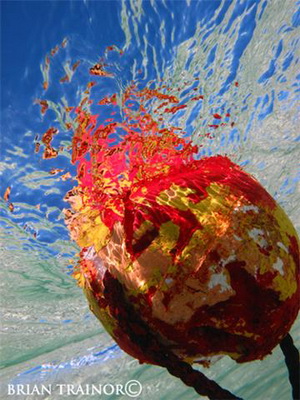 |
His perspective is unique and atypical.
“I knew that I didn’t want to shoot the traditional shots of Biscayne. I wanted to take a different direction. I realized that there was a lot of garbage around the park, and decided I needed to create something from this,” Trainor said.
He has been doing this type of photography for about three years, showing his work at street festivals around Miami. However, he has not photographed at locations outside of the state yet.
Trainor held his exhibition opening on Nov. 20 at the Dante Fascell Visitor Center at Biscayne National Park. He was pleased with the amount of support and interest he received from the public and was satisfied that the silent auction piece, “Captured” sold for more than expected.
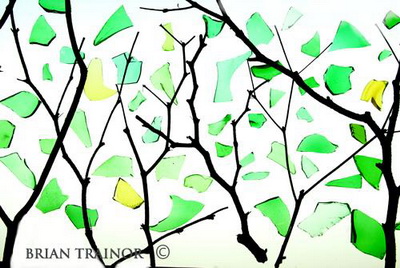 A red lobster trap buoy photographed on the ocean side of Elliott Key, “Captured” is a vibrant piece that incorporates the fiery red color from the actual trap as well as the clear blue-green water and sky. It almost looks as if the trap is on fire and will set the lobster free, contradicting its title.
A red lobster trap buoy photographed on the ocean side of Elliott Key, “Captured” is a vibrant piece that incorporates the fiery red color from the actual trap as well as the clear blue-green water and sky. It almost looks as if the trap is on fire and will set the lobster free, contradicting its title.
This was the last piece that was incorporated into the show. By that point, Trainor said he was mentally exhausted and that Bremen convinced him to keep it in the exhibition. It turned out to be the chosen auction item.
“Usually at silent auctions, a piece will go for less than the list price, but last night, I was happy that it sold for the going rate. Every cent from the silent auction is going to the South Florida National Park Trust,” Trainor said.
The trust works to improve and enhance the parks by defining their landscape. The money will go towards helping the parks keep their beauty and support their development.
The amount of pollution at Biscayne was Trainor’s theme and it gave him the idea to shoot the park with its surrounding trash. He would collect it and place it in an unusual way that made for an interesting visual image. He spent about a year collecting garbage for this project.
This waste, he explained, is contaminating the park’s waters and gradually killing wildlife, destroying the park and part of our ecosystem.
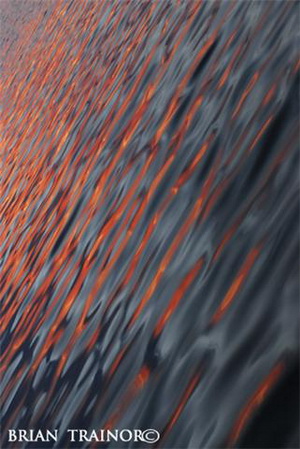 “Handle with Care,” one of Trainor’s pieces, shows this destruction, which is essentially the crux of his inspiration for this exhibit.
“Handle with Care,” one of Trainor’s pieces, shows this destruction, which is essentially the crux of his inspiration for this exhibit.
“How can you go wrong with bubble wrap in the ocean?” he laughs at the irony between the beautiful photograph and the reality of the danger the pollution is to the park.
Trainor said when looking at the mangroves, that all the surrounding garbage made it look almost like it was papier-mâché.
“If sea animals cannot get into their mangroves for protection, with all the garbage we are throwing into the ocean, we are giving up a generation of fish. We need this part [the mangroves]. It protects the shoreline and fish,” implores Trainor.
To come up with the titles of his pieces, he posted some of the photographs on Facebook and asked the users for their input. Bremen also helped him to come up with several of the titles.
“I saw green leaves with broken glass around them and from that came the piece called ‘Leaves of Glass.’ There is a poet actually who has a poem called ‘Leaves of Grass’ so I played with it a little and Gary actually came up with that one,” Trainor said of one of his photographs.
The glass in the photograph is part of the pollution in Biscayne’s waters.
Consistent with Trainor’s distinct view of the park through his photographs, is the piece called “Fire in the Sky.”
“You know how people like to take the pretty pictures of the sunrise? Well, this is my version of it,” Trainor said.
He played with the reflections of light against the water, the redness from the sun, and the exposure and focus to get this shot. He prefers to use a manual camera rather than anything automatic. This way he has full control over every aspect of the photograph.
Aside from going to the individual islands in the park, he also visited Stiltsville, a popular boat hangout at Biscayne. He wanted to get a shot that nobody had of it.
Appropriately named, “Hanging Out,” this photograph is of a shirt hanging by clothespins on a line on top of one of the houses in Stiltsville. Part of the architecture of the house is seen at the bottom of the photo and the shirt is hanging above it upside down. The diagonal lines from a board beneath the shirt and the clothesline above it parallel each other creating an interesting visual flow.
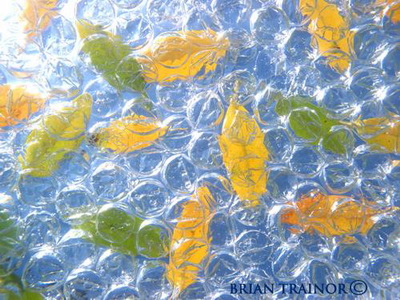 “You know how sometimes certain images or smells remind you of when you were growing up?” he asked. “To me, this image brings me back to when I used to see my mom hanging my clothes out in the sun. It’s a nice memory, that is crisp and fresh, just how the shirts ended up by the time they finished drying.”
“You know how sometimes certain images or smells remind you of when you were growing up?” he asked. “To me, this image brings me back to when I used to see my mom hanging my clothes out in the sun. It’s a nice memory, that is crisp and fresh, just how the shirts ended up by the time they finished drying.”
Matt Johnson, supervisor park ranger at Biscayne, said Trainor’s work has a unique eye.
“He finds beauty in things you don’t normally see. There are so many aspects of the park that are stunning and if it weren’t for photos like his you might miss them.” Johnson stated. “You have to look beneath the surface, and Brian does that. He goes all the way from the sky to what is inside the ocean.”
Trainor’s objective was to reach a common ground with the public, show the park in a different way, and express the importance of keeping our parks clean, to be able to share them with the generations to come.
“The good thing I’ve realized is that I can look back at my earlier work and say that it was amateurish. This means that now I know I’m growing as an artist,” Trainor said.
This exhibit speaks volumes on many levels without saying a word.
If You Go:
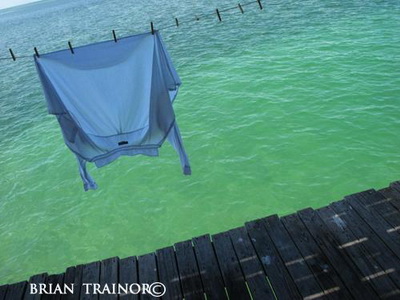 Dante Fascell Visitor Center is located at 9700 SW 328th St., Homestead, Fla. 33033.
Dante Fascell Visitor Center is located at 9700 SW 328th St., Homestead, Fla. 33033.- No entrance fee is required.
- For visitor information call 305-230-PARK (305-230-7275).
- Directions from the north: take the Florida Turnpike south, to Exit 6 (Speedway Boulevard). Turn left from exit ramp and continue south to SW 328th Street (North Canal Drive). Turn left and continue to the end of the road. It is approximately five miles, and the entrance is on the left.
- From U.S. 1: Drive south to Homestead. Turn left on SW 328th Street (North Canal Drive), and continue to the end of the road. It is approximately nine miles, and the entrance is on the left.
- From the South: traveling on U.S. 1 (Overseas Highway), drive north to Homestead. Turn right on SW 328th Street (North Canal Drive — first light after Florida Turnpike entrance), and continue to the end of the road. The entrance is approximately nine miles on the left.The Convoy Point parking area is open from 8 a.m. to sunset.
- The exhibition is going on from Nov. 20, 2009 through Feb. 15, 2010.
- The gallery is open from 9 a.m. to 5 p.m. every day.
- For further information on the exhibit, call 305-230-7275, or visit Brian Trainor’s website at http://wwwbriantrainorphotography.com
- To find out about the other services the park offers you can visit the website at http://www.biscayneunderwater.com.

Comments are Closed